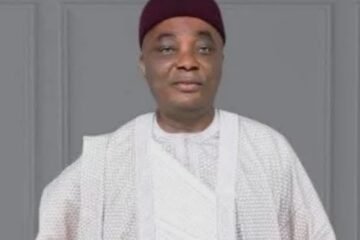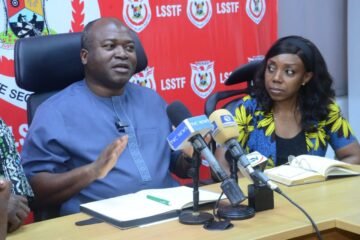
By ALOY EJIMAKOR
It’s often said that a lie told so many times, if unchallenged, may – in course of time – begin to pass for the truth. One of such is the terrible lie, institutionally purveyed since the end of the Civil War, to the effect that Igboland is landlocked or has no access to the sea. Just recently, President Buhari not only implied the same but he went further to derisively describe Igboland as a “dot in a circle”, using IPOB as a metaphor.
The purpose of this essay, therefore, is to debunk this lie with some simple historical and topographical evidence that are even in plain view, if you care to dig or do some basic physical explorations of your own.

Suffice it to say that it is a profound tragedy that entire generations of the immediate post-War Igbos never bordered to check but seemingly accepted this brazen institutional falsehood, largely intended to taunt the Igbo and put them down. A few that knew it to be false just didn’t care anymore.
And that History was constructively banned since the end of the Civil War made it worse, plus the fact that most people don’t take physical Geography (or even adventure) that serious anymore, otherwise they would have discovered that Abia, Imo and Anambra States have varying short-distance paths to the Atlantic through Imo, Azumiri and Niger Rivers.
It’s not really rocket science, as you can easily confirm this if you know how to read (or plot) Google Earth; or you conquer your fear of swamp snakes and walk through these areas on foot.
There are also many other hardly explored waterways and slithering tributaries, including the remote reaches of Oguta Lake and Urashi River at Oseakwa (Ihiala) that meandered through Igbo-delta wetlands to the Southeastern ends of the Atlantic waterfront.
These rivers have varying lengths of short navigational paths to the Atlantic, and in some cases, are far shorter nautically (and even on footpath) than the Portharcourt, Calabar and Ibaka seaports are to their side of the Atlantic.
Many of these pathways, including particularly the ones from the outer reaches of Imo and Azumiri Rivers terminate at the Atlantic at no more than 15 to 30 Nautical miles to the beachhead. To put it in lay language, one nautical mile equals 1.8 kilometers.
Thus, the contiguity of Southeast (not even the greater Igboland) to the Atlantic is nautically less than the Atlantic is to the seaports in Calabar, Onne, Ibaka, Lagos and Portharcourt. If you discount the territories unfairly excised from Igboland during State creations and the damnable boundary adjustments, it will be far less.
To be sure, Ikwerre land or Igweocha which bears the greater portions of the Portharcourt seaport was dredged up to 50 miles to the Atlantic front through the Bonny River. Onne seaport was dredged up to 60 miles to the Atlantic and Calabar seaport was dredged some 45 nautical miles to the Atlantic. Ibaka seaport is about 30 nautical miles to the Atlantic and the Lagos seaports dredged up to about 50 nautical miles to the Atlantic.
Compare all these to Obuaku in Abia State, which is only 25 nautical miles to the Atlantic from the confluence of Imo and Azumiri Rivers, of which Azumiri, on its separate merits, lies not more than 30 nautical miles to the Atlantic beachfront. The less obvious one is the little-known Oseakwa (Urashi) in Ihiala (Anambra State) which is mere 18 nauticals to the Atlantic, all with its 65 feet of natural depth, unarguably comparable to no other River in Nigeria.
Additionally, what is geopolitically known as Igboland today is far smaller than what it was and legally supposed to be. As far back as 1856, Baikie – one of the earliest and credible Geographers of ancient Nigeria, had this to say – “Igbo homeland, extends east and west, from the Old Kalabar river to the banks of the Kwora, Niger River, and possesses also some territory at Aboh, an Igbo clan, to the west-ward of the latter stream. On the north it borders on Igara, Igala and A’kpoto, and it is separated from the sea only by petty tribes, all of which trace their origin to this great race” (Baikie, William Balfour, published with a sanction of Her Majesty’s Government in 1856).
But with that infamous post-War abandoned property policy and the egregious institutional injustices in boundary adjustments, coupled with the widespread anti-Igbo gerrymandering, Igbos physically and psychologically lost political hold of their vested ancestral lands, all to the point of not caring anymore about their historical contiguity to the Atlantic, which their ancestors beheld and called ‘Oshimiri’ – The Great Sea.

The psychological beat-down and gang-up got so bad and institutional that some of the descendants of these Igbo ancestors (nearest to the Atlantic and now lying outside Southeast) are no longer sure whether they are Igbo or not.
The worst injustice was in 1976 when the Justice Nasir Boundary Adjustment Commission made a serious and targeted agenda of carving out core Igboland territories into some neighboring States of the South-South. But they didn’t quite make an absolute success of it. They missed the southernmost Southeast lands that possess Rivers that meandered through slices of Igbo-friendly South-South territories and ended up at the Atlantic, thus unwittingly (and luckily) placing Igboland and its right of access to the sea under the canons and realms of customary international law.
As it stands, international law of the sea guarantees Igboland (whether it remains Nigerian territory or not) unhindered access to the nearest sea (in this case: the Atlantic) peacefully through any of the various short-distance rivers, waterways and tributaries that originated from Igboland but ultimately washed into the Atlantic through contiguous SouthSouth territories.
For avoidance of doubt, there’s particularly the Obuaku confluence in Ukwa West (Abia State) that flows through greater Ikot Abasi in Akwa Ibom State before expanding out and washing into the near-reaches of the Atlantic. And the River Niger which ultimately joined the Atlantic through a vast network of hardly explored creeks and mangrove swamps that abut the Bight of Biafra (officially corrupted to Bight of Bonny, after the War).
Nigeria is subject to the International Law of the Sea and is therefore bound to abide by its provisions, should the need arise in a scenario of persistent sovereign oppression of the Igbo as an identifiable (and protected) indigenous group within Nigeria. The others are the United Nations Treaty of the Sea and the African Union Treaties and Conventions on the Sea, including particularly the African Charter on Human and People’s Rights, which Nigeria ratified and domesticated in 1983.
The pertinent provisions are mostly embedded in the copious protections relating to the collective economic and commercial rights of indigenous peoples lying within a Treaty nation. Ndigbo are undoubtedly an indigenous people presently lying within Nigeria.
So, international law will surely come into play should a belligerent or legal conflict arise out of Nigeria’s oppressive institutional resistance to granting a seaport to Igboland – an issue so fundamental and compelling that it bears the fulcrum of what is agitating the Igbo to the point of seeking an alternative to Nigeria.
Ejimakor, a Lawyer writes from Alaigbo.






964794 535729appreciate the effort you put into obtaining us this info 39329
239462 26750Nice weblog! Only dilemma is im running Firefox on Debian, and the web site is seeking slightly.. weird! Perhaps you may want to test it to see for yourself. 904810
236869 92329I dont leave a lot of comments on a lot of blogs each week but i felt i had to here. A hard-hitting post. 590298
108738 717319Hoping to go into business venture world-wide-web Indicates revealing your products or services furthermore companies not only to ladies locally, but nevertheless , to many prospective clients in which are online in most cases. e-wallet 583090
490963 88457You produced some initial rate factors there. I seemed on the internet for the difficulty and located most people will go along with together together with your internet site. 132318
can you buy clomid online can i buy generic clomid price where to buy generic clomiphene tablets how can i get clomiphene where buy cheap clomiphene can i get clomiphene without a prescription where can i buy generic clomiphene tablets
This is a keynote which is forthcoming to my heart… Myriad thanks! Faithfully where can I notice the connection details in the course of questions?
Thanks on putting this up. It’s understandably done.
azithromycin 250mg ca – purchase sumycin without prescription generic flagyl 200mg
buy semaglutide 14mg generic – buy periactin pills for sale cost periactin 4 mg
generic domperidone 10mg – oral sumycin 250mg cyclobenzaprine medication
inderal for sale – buy plavix 75mg for sale buy generic methotrexate over the counter
where to buy amoxil without a prescription – buy valsartan no prescription buy combivent 100mcg online
buy azithromycin generic – purchase bystolic without prescription buy bystolic 20mg without prescription
41003 593041Wohh just what I was seeking for, thanks for putting up. 683221
buy cheap generic clavulanate – https://atbioinfo.com/ buy ampicillin pills
order nexium pills – nexium to us nexium 40mg generic
buy deltasone 5mg pills – corticosteroid buy prednisone 40mg online cheap
buy ed pill – fastedtotake.com buy ed medications
amoxil where to buy – https://combamoxi.com/ buy cheap amoxil
buy diflucan – flucoan buy forcan for sale
oral cenforce 100mg – oral cenforce 50mg where to buy cenforce without a prescription
cialis overnight shipping – https://ciltadgn.com/# cheap canadian cialis
zantac 300mg without prescription – https://aranitidine.com/# buy zantac generic
cialis no prescription overnight delivery – https://strongtadafl.com/# max dosage of cialis
I’ll certainly carry back to be familiar with more. sitio web
buy viagra gold coast – this sildenafil 100mg price at walmart
I’ll certainly return to be familiar with more. https://ursxdol.com/sildenafil-50-mg-in/
More posts like this would create the online space more useful. https://buyfastonl.com/gabapentin.html
Thanks on putting this up. It’s understandably done. https://prohnrg.com/product/metoprolol-25-mg-tablets/
More delight pieces like this would create the web better. stromectol 6 mg
I’ll certainly carry back to review more. https://ondactone.com/product/domperidone/
I couldn’t weather commenting. Adequately written!
https://doxycyclinege.com/pro/ondansetron/
I am in truth enchant‚e ‘ to coup d’oeil at this blog posts which consists of tons of useful facts, thanks object of providing such data. https://experthax.com/forum/member.php?action=profile&uid=124575
buy forxiga 10mg online – https://janozin.com/# dapagliflozin for sale
xenical generic – on this site buy xenical for sale
311372 855646Thanks for this exceptional. I was wondering whether you were preparing of writing comparable posts to this 1. .Maintain up the outstanding articles! 316489
This website exceedingly has all of the information and facts I needed to this participant and didn’t positive who to ask. http://mi.minfish.com/home.php?mod=space&uid=1420934
51282 99628The next time I learn a weblog, I hope that it doesnt disappoint me as significantly as this 1. I mean, I do know it was my choice to read, nevertheless I truly thought youd have something attention-grabbing to say. All I hear can be a bunch of whining about something which you could fix for those that werent too busy in search of attention. 725987
You can shelter yourself and your family by being heedful when buying panacea online. Some pharmacy websites function legally and offer convenience, solitariness, sell for savings and safeguards over the extent of purchasing medicines. buy in TerbinaPharmacy https://terbinafines.com/product/risperdal.html risperdal
… [Trackback]
[…] Find More here on that Topic: famousreporters.com/igboland-is-not-a-dot-and-its-not-landlocked/ […]
I am in truth enchant‚e ‘ to coup d’oeil at this blog posts which consists of tons of worthwhile facts, thanks for providing such data. TerbinaPharmacy
More posts like this would make the online play more useful.
451827 320893conclusion that you are absolutely right but some demand to be 811111
… [Trackback]
[…] Read More to that Topic: famousreporters.com/igboland-is-not-a-dot-and-its-not-landlocked/ […]